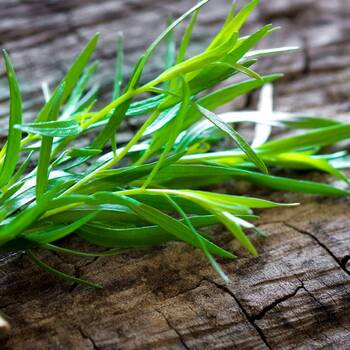
How to Grow Russian Tarragon Seeds
Grow Guide #2403
Family: Asteraceae
Binomial name: Artemisia dracunculus
Life Cycle: Perennial
This 'How to Grow' guide details everything a home gardener needs to know to plant, grow and care for Russian tarragon (Artemisia dracunculus).
When to Sow Russian tarragon Seeds
Russian tarragon is a perennial plant that grows year round in most climates. Use the table below to identify the best time of year to sow Russian tarragon seeds in your climate.
| JAN | FEB | MAR | APR | MAY | JUN | JUL | AUG | SEP | OCT | NOV | DEC | |
|---|---|---|---|---|---|---|---|---|---|---|---|---|
| Cool | ||||||||||||
| Temperate | ||||||||||||
| Sub-Tropical | ||||||||||||
| Tropical | ||||||||||||
| Arid |
Preparation
Russian tarragon plants are best grown in full sun or part shade. Choose a location that will receive at least 3 hours of full sun each day.
Russian tarragon plants are perennial, meaning they live for several years. Choose a permanent position where plants can grow undisturbed by regular digging.
Russian tarragon plants need a well drained soil enriched with plenty of organic matter. Prepare soil by weeding it thoroughly, digging it over to loosen it and adding aged animal manure or compost. Keep the area free of weeds until planting. Learn more about preparing soil for planting here.
Russian tarragon plants can be grown in containers. If possible choose a variety that’s recommended for container growing. Use a good quality potting mix and make sure your container is large enough for mature plants; a minimum of 20 litres is recommended for Russian tarragon. During the growing season, keep in mind that container grown plants may need additional fertiliser to encourage healthy growth.
How to Sow Russian tarragon Seeds
Russian tarragon seeds do not require any treatment (eg soaking, stratification) before sowing.
Russian tarragon seeds grow best when they are raised in trays or other containers and transplanted to the garden once established.
- Fill trays, punnets or jiffy pots with a good quality seed-raising mix, or use soil starter pellets.
- Sow seeds 1mm deep.
- Keep soil moist but never wet or dry.
- Seeds should germinate in around 10-14 days at a soil temperature of 15-20°C.
- Transplant seedlings to the garden once they have their first true leaves and are large enough to handle (usually 5-10cm tall).
- Plant out, spacing plants 50cm apart.
Russian tarragon is a half hardy crop. Mature plants will survive light frosts but seedlings need protection until they are established. Do not transplant seedlings or sow seeds outside until all danger of frost has passed.
Optional: In cool climates Russian tarragon seeds can be sown indoors 6 weeks before the last expected frost. Grow them in a warm position with plenty of natural light.
How to Grow Russian tarragon
Russian tarragon plants may need watering during the growing season. Water when the soil is dry about 5cm below the surface (test this by scratching away a little soil with your finger). Water deeply in the early morning or late afternoon. Avoid watering the leaves of plants to avoid fungal diseases. Learn more about watering here.
If soil was well prepared no extra fertiliser should be necessary. In poor soil or to give your plants an extra boost, application of a high-nitrogen fertiliser or one formulated for leafy greens or herbs can be beneficial:
- Apply slow release fertiliser at the recommended rate when transplanting or when seedlings are 5-10cm tall.
- Apply liquid fertiliser at the recommended rate and frequency during the growing season.
When plants have finished flowering prune them back to neaten them and encourage strong new growth. Using sharp secateurs or snips, cut individual stems just above a set of lower leaves.
How to Harvest Russian tarragon
Russian tarragon should be ready to harvest in approximately 90-100 days.
Russian tarragon is ready to harvest when the stems have grown long enough to pick, and can be harvested as needed. Harvest by pinching off the outer stems and leaves, leaving some on the plant for future growth. Tarragon stems can be stored short term in a perforated plastic bag in the fridge. For longer term storage tarragon can be dried.
Common Problems when Growing Russian tarragon
Like all plants, Russian tarragon is susceptible to some pests, diseases and other problems. Below is a list of the most common problems gardeners encounter when growing Russian tarragon plants:
 Rust (Puccinia sp.) is a fungal disease that causes brown to orange raised spots or patches to appear on foliage. Fungal spores are spread by wind or water to neighbouring plants, especially in temperatures of 10-20C and when humidity is high. To manage rust, space plants to avoid overcrowding, grow them in the recommended amount of light (eg full sun), do not over fertilise crops, remove dead plants and practice crop rotation. Read more about rust fungus here.
Rust (Puccinia sp.) is a fungal disease that causes brown to orange raised spots or patches to appear on foliage. Fungal spores are spread by wind or water to neighbouring plants, especially in temperatures of 10-20C and when humidity is high. To manage rust, space plants to avoid overcrowding, grow them in the recommended amount of light (eg full sun), do not over fertilise crops, remove dead plants and practice crop rotation. Read more about rust fungus here. Slugs and snails are molluscs that feed on tender leaves and shoots, mostly at night, leaving slimy trails behind them. Control them by removing their hiding places, keeping free range poultry, collecting them by torchlight or by placing traps. Read more about slugs and snails here.
Slugs and snails are molluscs that feed on tender leaves and shoots, mostly at night, leaving slimy trails behind them. Control them by removing their hiding places, keeping free range poultry, collecting them by torchlight or by placing traps. Read more about slugs and snails here.


.png)



